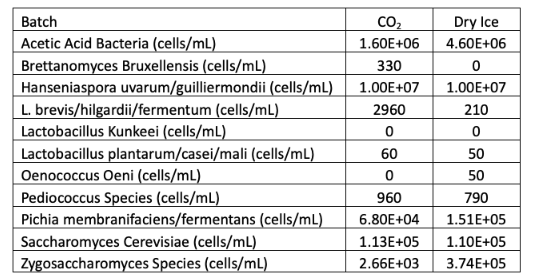Strategies to exclude oxygen and minimize spoilage in ambient fermentations of Cabernet Franc (CO2 vs Dry Ice) (2020)
Todd Henkle
The Vineyards and Winery at Lost Creek
Summary
At the Vineyards and Winery at Lost Creek, red wines have been fermented without the addition of commercial yeast since 2016. The purpose of this experiment was to compare the effects of two methods of oxygen exclusion, dry ice and CO2 gas on volatile acidity. The fermentation treated with CO2 completed fermentation with lower volatile acidity than the fermentation that received dry ice, however both had relatively high acetic acid levels at the completion of fermentation (0.58 g/L & 0.68 g/L) as well as at the completion of malolactic fermentation (0.73 mg/L and 0.93 mg/L). Ethyl acetate values were below threshold for both treatments.
Introduction
At the Vineyards and Winery at Lost Creek, red wines have been fermented without the addition of commercial yeast since 2016. They believe that the greater diversity in the microbial population during ambient fermentation leads to more complex finished wines. However, ambient fermentation also includes a greater level of risk, and can lead to elevated levels of acetic acid and ethyl acetate. Spoilage organisms such as Acetobacter and Hanseniaspora use oxygen as part of the metabolic pathway to production of acetic acid and ethyl acetate, so exclusion of oxygen is one way to limit volatile acidity. The purpose of this experiment was to compare methods of oxygen exclusion as a way of reducing volatile acidity in non-inoculated fermentations. In one treatment, the standard protocol of the winery was used; CO2 gas was blanketed throughout fruit processing and on top of bins during cold soak. In a second treatment, dry ice was used instead of CO2 gas.
Methods
After harvest, grapes were chilled overnight prior to processing. Fruit was sorted and destemmed into Tbins with 15% whole cluster inclusion and no crushing. Sulfur dioxide (40 ppm) and Stab Micro M (2 g/hL) were also added at this time. Both bins received 10% (57 L) saignée.
-
One bin was sprinkled with dry ice during fruit loading, then covered in plastic and returned to the refrigerator for cold soak.
-
The other bin was covered in plastic, gassed with CO2, and returned to the refrigerator for cold soak.
Both bins were cold soaked for 2 days. At the completion of cold soak, juice samples were taken for general chemistry and microbiology. Samples were sent to ETS labs in California for microbiological analysis. Freezing kills off some microbes, and although some will survive, they do not generally represent the entire population that was present before freezing. Rich De Scenzo from ETS recommended a method whereby samples were centrifuged, the juice was poured into a new tube, leaving a small amount on the pellet, capping both tubes and shipping them to ETS overnight, thus preventing fermentation during shipment. The samples were reconstituted upon arrival at ETS.
After cold soak, both bins were allowed to warm in the cellar for ambient fermentation. Bins were punched down once per day and gassed until signs of fermentation, at which time they were actively heated and punched down three times per day. Heating lasted for 4 days. Tartaric addition was made to a common target (with the CO2 bin receiving 3.2 g/L and the dry ice bin receiving 3.1 g/L). Wine in both bins underwent extended maceration with 24 days of skin contact with daily gassing after CO2 was no longer being produced by the fermentation. After pressing, wine was allowed to settle, then transferred to carboys for malolactic fermentation. Malolactic fermentation was determined complete in December, when 70 ppm SO2 was added and wine was bottled for analysis.
Results
The general chemistry of the fruit was very similar between the bins, especially after cold soak (Table 1). When compared with initial chemistry, the pH and potassium of the fruit are higher after cold soak while TA and tartaric acid are lower. There is no consistent effect of cold soak on YAN in this case. Microbes present in the must after the cold soak were also similar between bins (Table 2) with the dry ice bin having roughly twice as many Piciha and Acetic Acid bacteria. For both bins, Acetic acid bacteria were 10 times more prevalent than Saccharomyces while Hanseniaspora were 100 times more prevalent.
Fermentation started within two days of bins being brought into the cellar and proceeded steadily with little difference in rate or temperature between bins (Figure 1). Dry Ice is itself cold, however the cold soak likely evened out any temperature differences between lots. The lot treated with dry ice finished fermentation with higher volatile acidity and lower alcohol conversion than the lot treated with CO2 (Table 3). Both lots had less than 1.0 g/L of residual sugar, so differences in alcohol are not due to differences in the completion of fermentation. A comparison of volatile acidity at several checkpoints during the winemaking process indicates the volatile acidity accumulation occurred primarily during alcoholic and malolactic fermentation (Table 4). Ethyl acetate levels are below the detection for spoilage in both bins (Table 4).
Table 1: Fruit chemistry before and after cold soak for two treatments of ambient fermented Cabernet Franc (in-house data)

Table 2: Microbiology of fruit for treatments of ambient fermented Cabernet Franc taken 2 days after processing (ETS Labs)

Table 3: Finished wine chemistry for two treatments of ambient fermented Cabernet Franc (ICV Labs)

Table 4: Evolution of volatile acidity (g/L) for two treatments of ambient fermented Cabernet Franc. Ethyl Acetate is reported in mg/L. (in-house data and ICV labs)

Figure 1: Fermentation kinetics for two treatments of ambient fermented Cabernet Franc
(in-house data)

